How to Improve TV and Digital Video Advertising Campaigns as Viewing Habits Change
Video content has proved adept at engaging audiences with its combination of sight, sound and motion. And for years, TV was the main vehicle for audiences to consume video content on a regular basis. The combination of these two factors has driven years of heavy investment in TV commercials.
But, things have changed. Video content remains a powerful way to engage, but audiences have a lot more ways to consume that content.
How TV viewing habits have changed
Here’s an example of what I mean: On a recent Monday night, I sat down to watch Last Week Tonight with John Oliver. The show airs on Sundays and even though I usually catch each episode, I rarely get to it that early in the week.
But that Monday, I watched part of the main story on YouTube earlier in the day and was intrigued. So that evening, I turned on the TV, scrolled to the HBO app and commenced viewing a couple days early.
Watching clips (or entire episodes) on my phone, starting and stopping episodes as I please, relying on apps over standard cable – all of this TV viewing behavior has become the norm for me and millions of others in the United States, especially among the millennial generation.
The trend has been accelerated by Over-the-Top (OTT) services like Netflix, Hulu and Amazon Prime Video, who have become just as much content producers as aggregators. Unlike hybrids like HBO or Showtime, these platforms don’t have a standard cable TV presence and therefore don’t have to follow standard cable TV conventions. Rather than airing shows at a set time each week, they often upload entire season’s worth of episodes at a time, allowing audiences to enjoy them as they see fit.
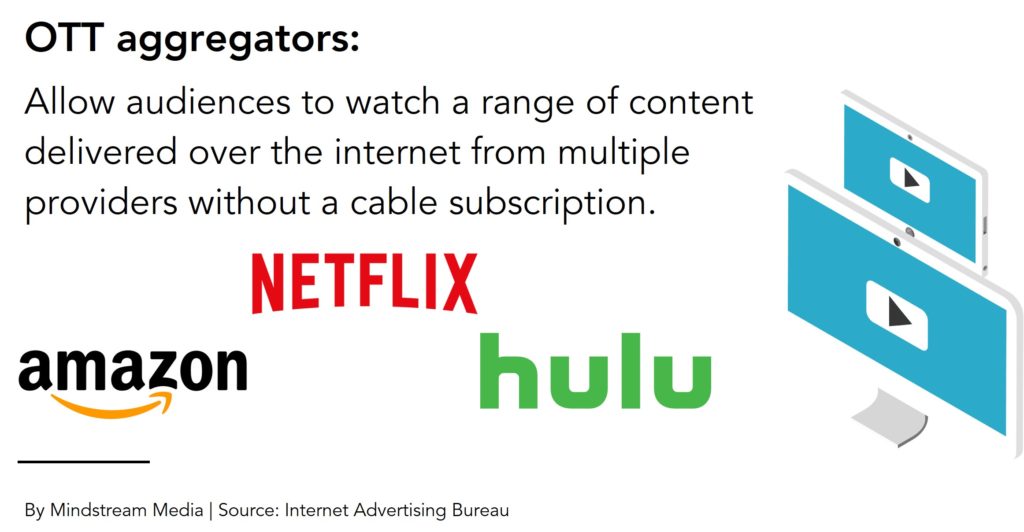
This behavior is a far cry from TV viewing behaviors in the recent past. There was a time, not so long ago, when if you wanted to watch a show, you had better have been in your living room in front of that TV when it aired or you were out of luck. (Unless you could pull off the miracle of recording a program with a VCR – which, if I remember correctly, had a success rate of about 4 percent.)
Rigid viewing schedules have become untenable for today’s digital audiences. People expect to watch their favorite shows whenever they want, and the living room TV no longer enjoys an in-home monopoly on video content. People are watching shows on any device, at any time, from anywhere they want.
This dramatic shift in the way people consume video content has changed the way showrunners produce content. For example, shows have become more serialized, allowing plots to unfold with each episode, making it easier for audiences to binge watch.
Commercial formats have changed too, becoming more interactive and audience-driven. Hulu, for example, allows brands to sponsor limited commercial experiences and give audiences the choice of the ad creative they see.

How digital video complements TV
Show producers are also adapting to consumer desire for content that complements their favorite programs. A plethora of inter-connected devices allows users to move between traditional and digital video seamlessly. Some of digital video viewing time is replacing TV, but some of it is spent watching content related to their favorite shows.
For example, winter finally came this summer with HBO’s “Game of Thrones” long-awaited premiere in July. That summer, for every hour spent watching the show on live TV, audiences watched 30 minutes of “Game of Thrones”-related videos on YouTube, according to Google.
The blurring line between TV and digital video
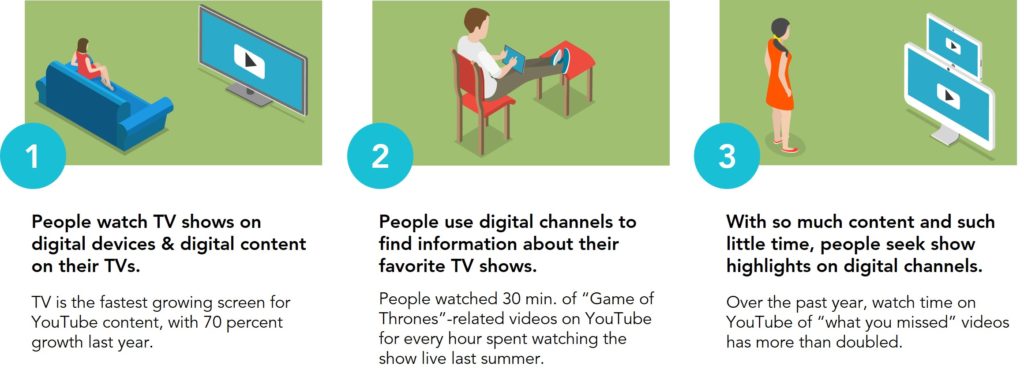
How digital video has replaced TV
The relationship between traditional TV and digital video isn’t always collaborative. There’s a growing number of cord-cutters – those ditching traditional cable subscriptions – and cord-nevers – those who never even had a cable subscription.
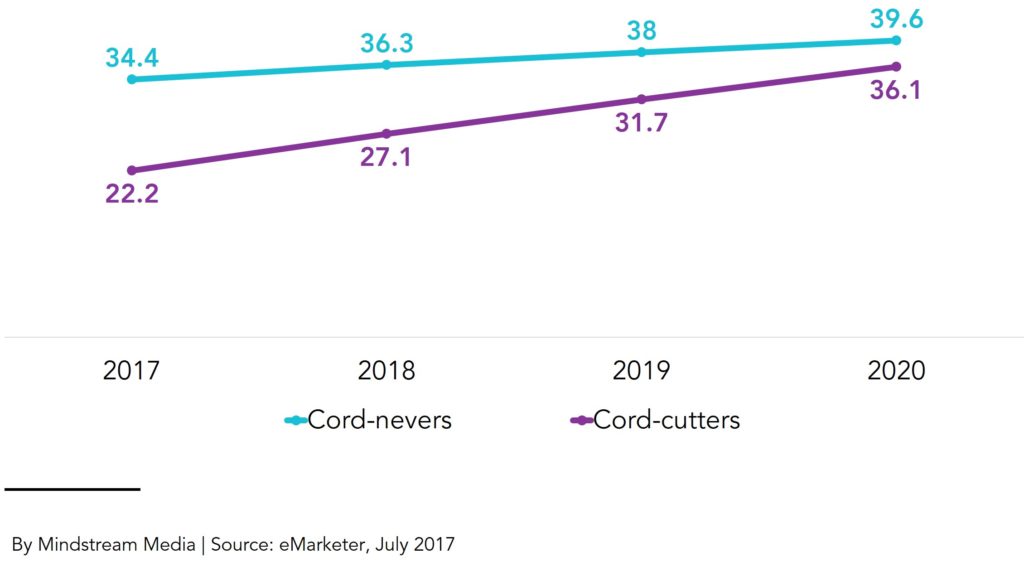
These rejectors of cords tend to skew younger, creating a noticeable shift in the average TV viewer. During the 2017-2018 season, the median age of viewers was over 50-years-old for nine of the top 10 network TV shows.
Median ages of viewers for the top 10 entertainment shows during the 2017–2018 television season
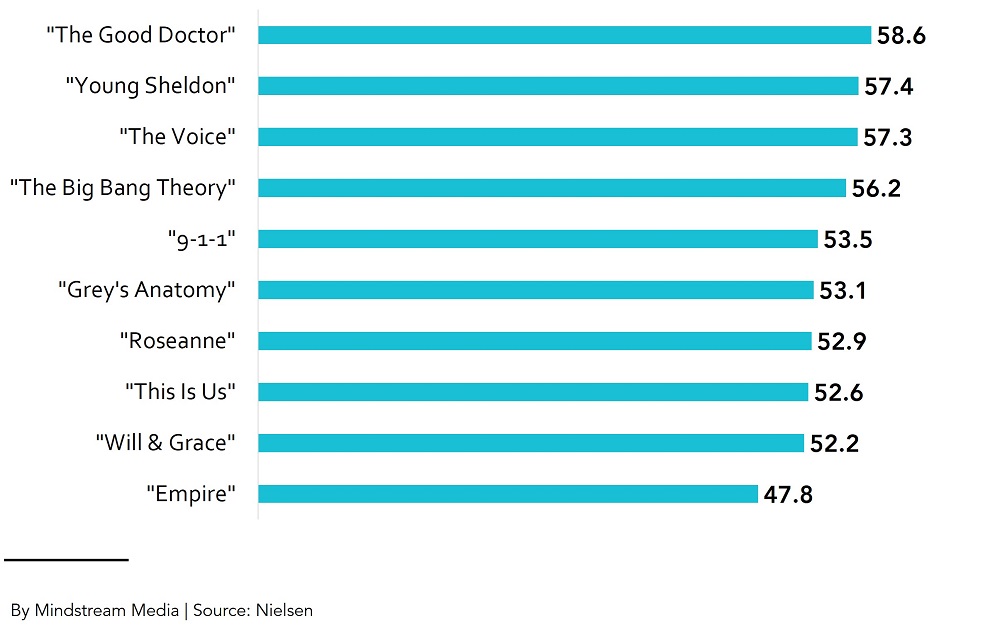
What advertisers need to do
TV is not, as some have claimed, dead. It’s still a viable medium to reach massive audiences. However, the way those audiences watch TV has definitely changed. Brands need to embrace this new reality and change their video advertising strategies accordingly.
A change in advertising strategy starts with a change in mindset. Here’s how Anne Schelle, Managing Director at Pearl TV, described the dynamic in the IAB’s Guide to Digital Video Advertising (emphasis added):
There’s a lot of talk about the marketplace becoming increasingly ‘fragmented’, however a more accurate description might be that it’s becoming increasingly “interconnected”, with consumers seamlessly accessing content across more screens than ever before. The lines between desktop, mobile, TV and film are beginning to blur as the various platforms are often more distinguished by differences in use case than by the underlying technology.
Advertisers need to embrace the new reality of media consumption and start treating video content the same way audiences do – as an interconnected medium where the device displaying the content matters far less than the content itself.
How brands can blend digital and traditional video strategies
Brands have started to catch on to the changing media landscape and shifted ad dollars accordingly. However, digital ad spending still has not caught up to the share of time users spend with the devices. In 2018, U.S. adults will spend 52 percent of their time on digital devices. Advertisers, however, are projected to allocate just 46 percent of dollars to digital.
The share of average time spent per day with select media by U.S. adults vs. U.S. ad spending share
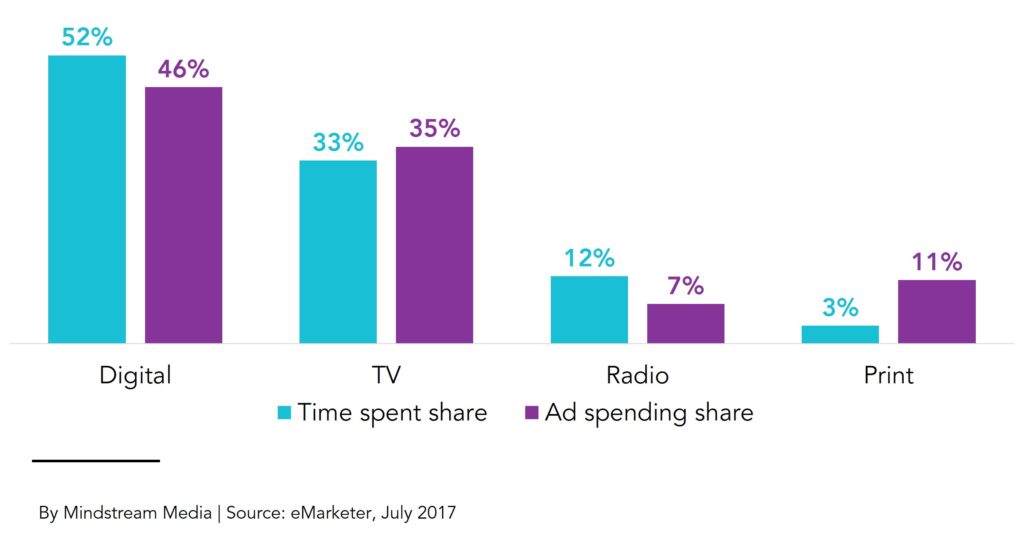
This trend is important as ad spend should reflect consumer behavior, but it’s important that brands take a strategic approach to shifting ad dollars and not completely drop traditional media, especially TV.
Time and again, TV has proved itself as an effective way to reach mass audiences. So, instead of completely shifting away, brands should develop a holistic video advertising approach that incorporates traditional TV (broadcast and cable), digital video platforms (e.g., Hulu) and programmatic ad buys on sites like YouTube and Facebook.
Brands can’t just copy and paste TV commercials into digital channels. While keeping a consistent overall approach, it’s important that brands optimize campaign strategies and ad creative for each channel and platform. At the beginning of each campaign, advertisers should be thinking “what are all the channels this ad could appear on?” and “what do I need to do to make sure the ad is optimized for each one?”
To carry out this strategy, most brands will need to look outward to find a media agency capable of buying ad space on both traditional TV and digital video channels. However, years of siloing traditional and digital media have created a lot of specialty agencies that do one or the other, and less full-service agencies capable of providing both.
On that note, brands aren’t the only ones who need to shift their approach. All parties involved – content producers, brand advertisers and marketing agencies alike – need to adapt their thinking to this new interconnected video landscape. Because, one thing is for sure, audiences have.
Want to learn how Mindstream Media Group’s digital and traditional video solutions can help you reach target audiences?
Contact us today.
More from Mindstream Media Group

Meet the Mindstreamer – Chandler Swanner
Chandler Swanner’s interest in advertising dates back to her childhood. Her mother (and role model in life) was a Media […]

Third-Party Cookie Phase-Out: What Marketers Need to Know
Cookies are an essential part of internet usage, allowing websites to remember you and provide a more personalized experience. This […]

Meet the Mindstreamer – Kaya Bucarile
She plans and oversees media strategy for agency clients, working closely with project and platform managers to ensure that we […]
